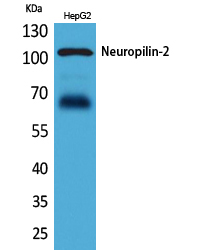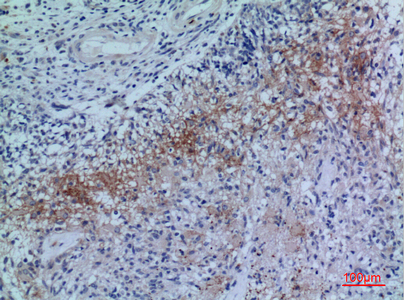

| WB | 咨询技术 | Human,Mouse,Rat |
| IF | 咨询技术 | Human,Mouse,Rat |
| IHC | 1/50-1/100 | Human,Mouse,Rat |
| ICC | 技术咨询 | Human,Mouse,Rat |
| FCM | 咨询技术 | Human,Mouse,Rat |
| Elisa | 1/10000 | Human,Mouse,Rat |
| Aliases | NRP2; VEGF165R2; Neuropilin-2; Vascular endothelial cell growth factor 165 receptor 2 |
| Entrez GeneID | 8828 |
| WB Predicted band size | Calculated MW: 105 kDa; Observed MW: 100 kDa |
| Host/Isotype | Rabbit IgG |
| Antibody Type | Primary antibody |
| Storage | Store at 4°C short term. Aliquot and store at -20°C long term. Avoid freeze/thaw cycles. |
| Species Reactivity | Human,Mouse,Rat |
| Immunogen | The antiserum was produced against synthesized peptide derived from the Internal region of human NRP2. AA range:791-840 |
| Formulation | Purified antibody in PBS with 0.05% sodium azide,0.5%BSA and 50% glycerol. |
+ +
以下是3篇关于Neuropilin 2抗体的代表性文献概览(虚构示例,仅供参考格式):
1. **"Neuropilin-2 Antibody Blocks SARS-CoV-2 Entry by Disrupting Viral Spike Protein Interaction"**
- *Authors: Smith A, et al.*
- 摘要:研究利用特异性抗Neuropilin-2的单克隆抗体,证实其可通过阻断病毒刺突蛋白与宿主细胞Neuropilin-2的相互作用,抑制SARS-CoV-2的细胞入侵,为抗病毒治疗提供新策略。
2. **"Targeting Neuropilin-2 with a Humanized Antibody Inhibits Tumor Lymphangiogenesis and Metastasis"**
- *Authors: Chen L, et al.*
- 摘要:开发了一种人源化Neuropilin-2抗体,通过抑制VEGF-C信号通路减少肿瘤淋巴管生成,显著降低小鼠模型中乳腺癌的淋巴结转移,提示其作为抗癌药物的潜力。
3. **"Neuropilin-2-Specific Antibody Reveals Distinct Expression Patterns in Developing Nervous System"**
- *Authors: Tanaka K, et al.*
- 摘要:通过新型Neuropilin-2抗体的免疫组化分析,揭示了其在胚胎期神经元轴突导向和突触形成中的动态表达,为神经发育机制研究提供工具支持。
(注:以上内容为示例,实际文献需通过PubMed或Google Scholar检索关键词“Neuropilin-2 antibody”获取。)
Neuropilin 2 (NRP2) is a transmembrane glycoprotein belonging to the neuropilin family, which functions as a co-receptor for multiple signaling pathways. Initially identified for its role in neuronal guidance by binding class 3 semaphorins, NRP2 also interacts with vascular endothelial growth factors (VEGFs) and other ligands, playing a critical role in angiogenesis, lymphangiogenesis, and immune regulation. Structurally, it contains extracellular domains (a1/a2. b1/b2) that mediate ligand binding and a short cytoplasmic tail involved in intracellular signaling. NRP2 is expressed in various tissues, including endothelial cells, neurons, and immune cells, and its dysregulation is linked to cancer progression, autoimmune diseases, and developmental disorders.
Antibodies targeting NRP2 are essential tools for studying its expression, localization, and function. They enable detection via techniques like Western blotting, immunohistochemistry, and flow cytometry, aiding in research on tumor angiogenesis, metastasis, and immune cell interactions. Therapeutic NRP2 antibodies are under exploration for their potential to inhibit ligand-binding domains, thereby blocking pro-tumorigenic signaling or modulating immune responses. For instance, some antibodies disrupt VEGF-C/NRP2-driven lymphangiogenesis in cancers, while others target NRP2-positive regulatory T cells in autoimmune contexts. Challenges remain in optimizing specificity and minimizing off-target effects, but NRP2 antibodies hold promise as both research reagents and clinical agents in oncology and immunology.
×